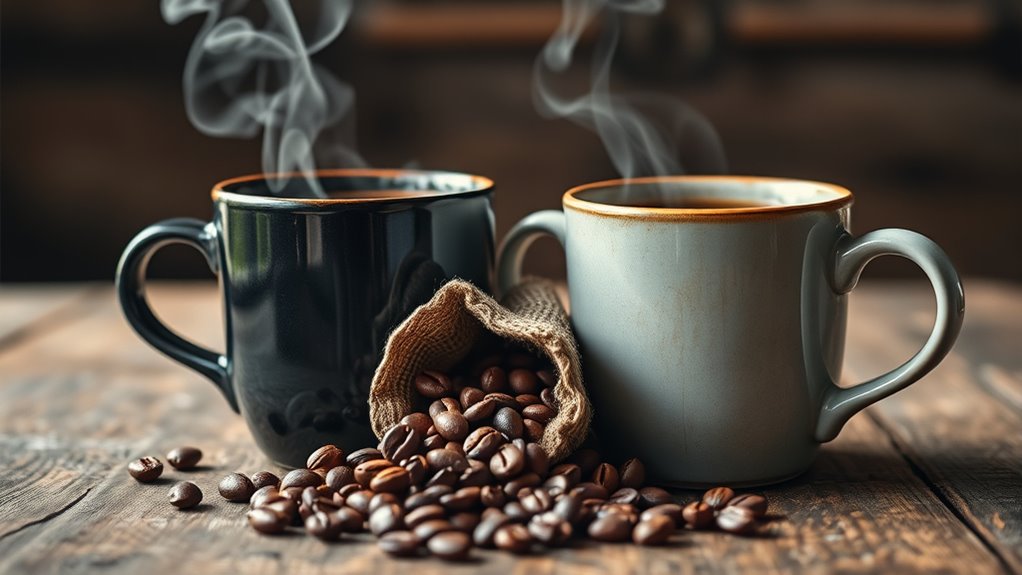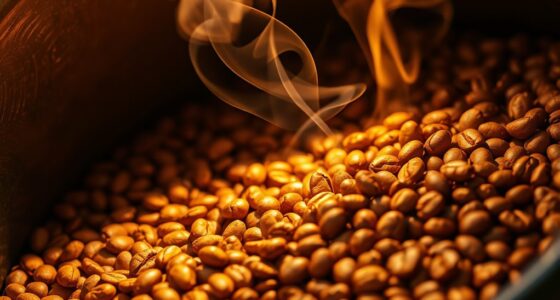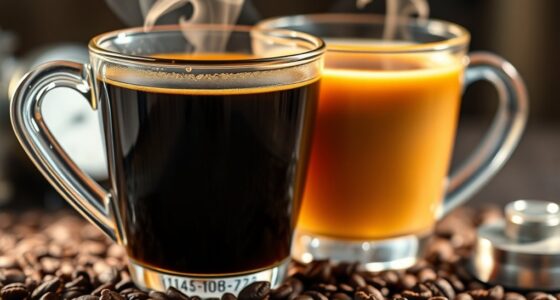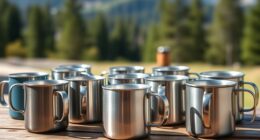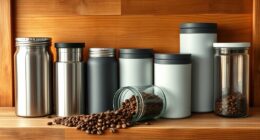Contrary to popular belief, dark roast coffee doesn’t have less caffeine than lighter roasts. During roasting, caffeine remains stable even as beans lose moisture and change in flavor. Factors like brew method and grind size play a bigger role in how much caffeine ends up in your cup. So, if you’re after a caffeine kick, the roast level isn’t the main factor—there’s more to uncover about how different brewing styles influence caffeine.
Key Takeaways
- Dark roasts do not contain significantly less caffeine than light roasts; roasting doesn’t affect caffeine levels.
- Caffeine remains stable during roasting, so levels are similar regardless of roast darkness.
- Bean density differences influence extraction, but not the total caffeine content in the bean.
- Brewing method and grind size impact caffeine extraction more than roast level.
- Focus on bean type and serving size rather than roast darkness to gauge caffeine strength.
The Science Behind Coffee Roasting and Caffeine Content
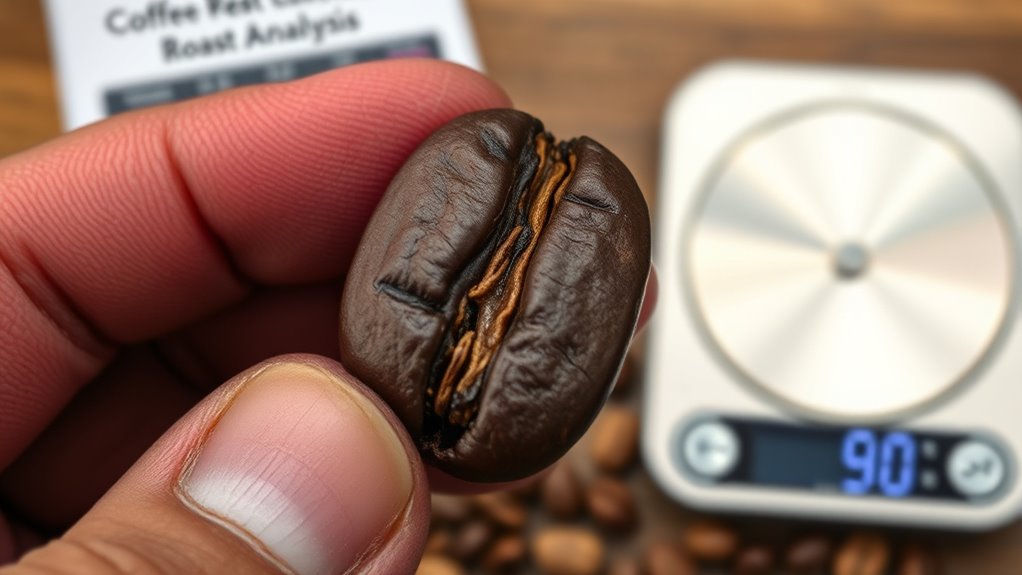
While many people assume darker roasts have more caffeine, the truth is that the roasting process actually affects caffeine levels very little. During bean roasting, the coffee aroma becomes richer and more intense, but caffeine remains stable because it’s naturally resistant to heat. As beans undergo roasting, their weight decreases due to moisture loss, but caffeine content stays mostly unchanged. This means that whether you prefer a light or dark roast, the caffeine amount in your cup is similar. The transformation of flavors and aroma from bean roasting is what mainly varies, not the caffeine. So, your choice of roast level shouldn’t be based on caffeine content but on taste preferences, as roasting doesn’t considerably alter the caffeine present. Additionally, tuning methods in cars demonstrate that modifications often aim to optimize performance without changing core components, much like how roasting changes flavor but not caffeine.
How Roast Levels Affect Coffee Bean Density and Caffeine Extraction

As coffee beans are roasted to different levels, their density changes considerably, which directly influences how caffeine is extracted during brewing. Lighter roasts tend to have higher coffee bean density because the beans retain more of their original structure. This increased density allows water to penetrate more effectively, often resulting in higher caffeine extraction efficiency. Conversely, darker roasts are less dense due to the breakdown of cell structures during roasting, which can make caffeine extraction slightly less efficient. Additionally, the cell structure changes during roasting impact how caffeine is released, further influencing the brewing process. However, this doesn’t mean dark roasts have less caffeine overall; it simply affects how quickly or easily caffeine is released during brewing. Understanding these density changes helps clarify how roast levels influence the caffeine you ultimately consume.
Comparing Caffeine Levels in Different Brew Methods
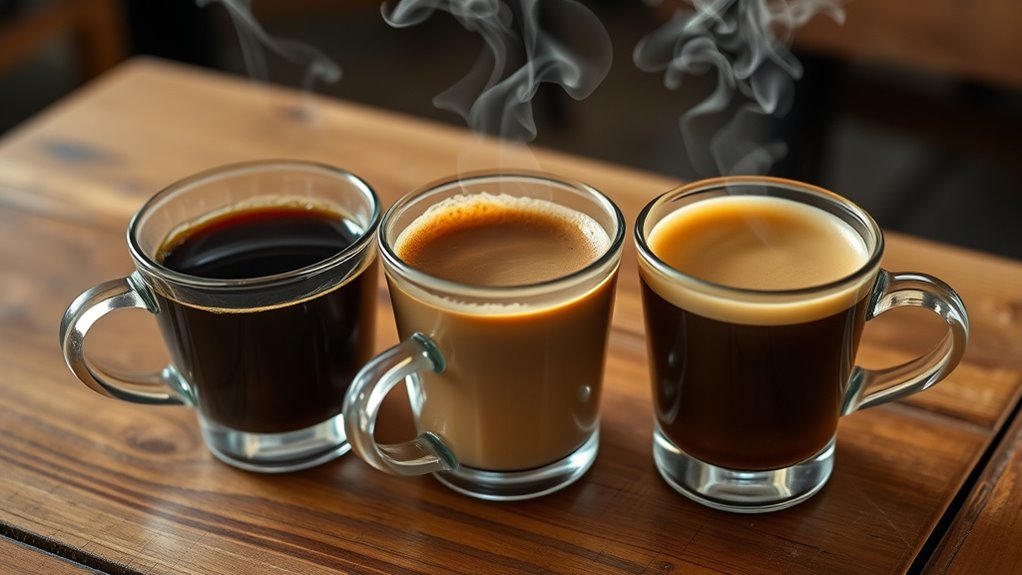
The way you brew your coffee considerably impacts the caffeine content of your cup. Different brew methods extract caffeine uniquely, influenced by factors like coffee grind and brewing temperature. For example, a French press uses a coarse grind and hot water, resulting in a richer extraction, while drip brewing employs medium grind and steady temperature. To visualize:
| Brew Method | Coffee Grind | Brewing Temperature |
|---|---|---|
| Espresso | Fine | Very hot (~200°C) |
| Pour-over | Medium-fine | Hot (~90-96°C) |
| Cold Brew | Coarse | Cold (~4°C) |
Using finer grinds and higher temperatures generally increases caffeine extraction, but over-extraction can lead to bitterness. Understanding these variables helps you control caffeine levels in your brew. Additionally, coffee extraction techniques play a significant role in determining the final caffeine content and flavor profile of your coffee.
Debunking Common Myths About Dark Roast and Caffeine
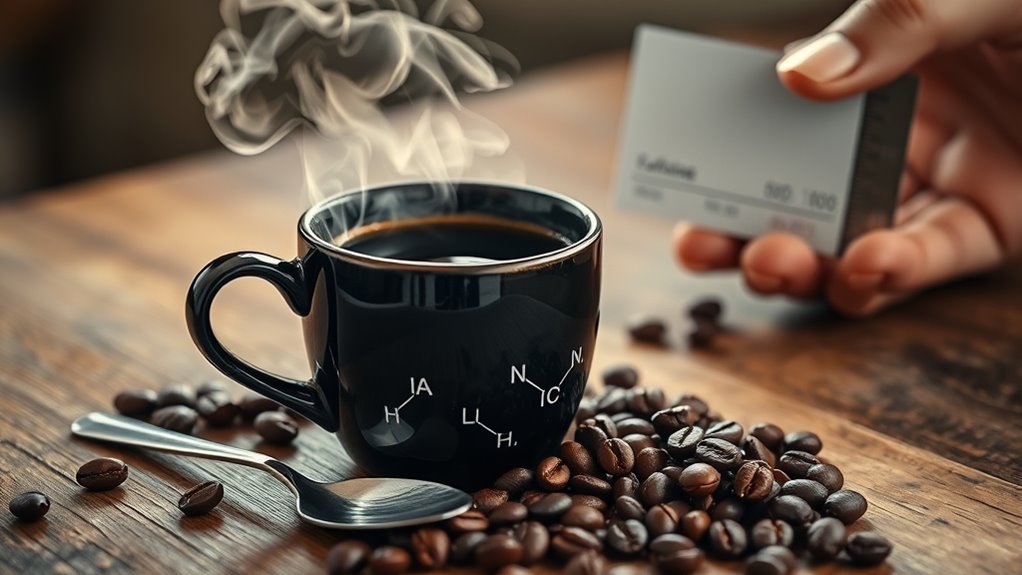
Many people believe that dark roast coffee contains less caffeine than lighter roasts, but this isn’t true. The misconception often comes from the bolder flavor profiles of dark roasts, which can mask caffeine content. In reality, roasting level has minimal impact on caffeine levels; the difference is usually negligible. Decaffeination processes remove most caffeine without altering the coffee’s flavor profile substantially, so a decaf dark roast still retains its rich, smoky notes. Conversely, lighter roasts tend to preserve more of the beans’ original caffeine content because they undergo less processing. Understanding these processes helps you see that caffeine content is more influenced by bean type and serving size than roast darkness, debunking the myth that dark roasts are inherently weaker in caffeine. Additionally, roasting level does not significantly alter the caffeine content, emphasizing that factors like bean origin and brewing method are more important.
Tips for Choosing Your Coffee Based on Caffeine Content
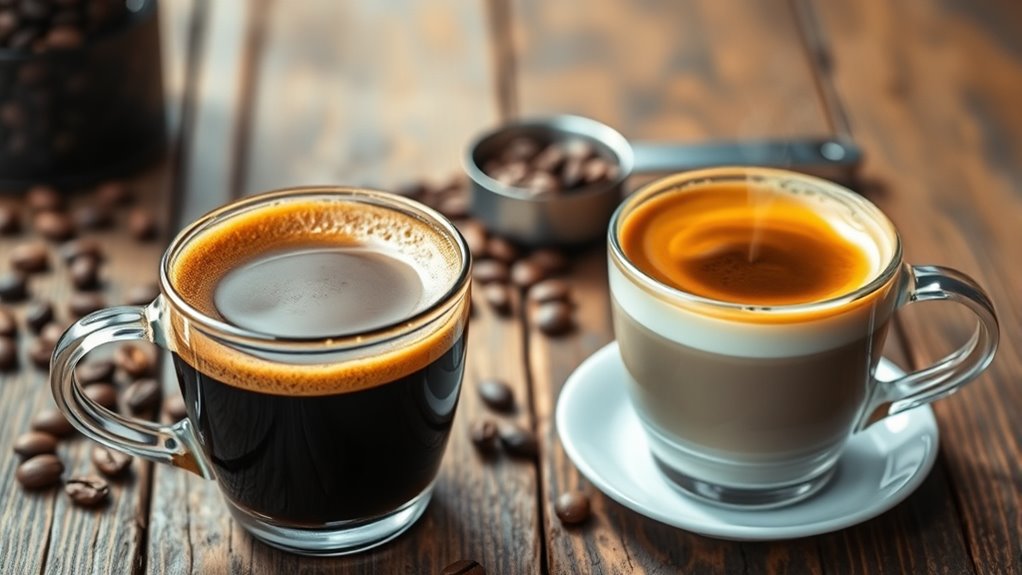
Understanding that roast level has little effect on caffeine content empowers you to choose coffee based on your caffeine preferences. If you’re sensitive to caffeine, explore decaffeinated options—they offer the flavor you enjoy without the jitters. Pay attention to brewing methods; a drip brew typically has more caffeine than a single espresso shot, so adjust accordingly. Reading labels can also help; some brands specify caffeine content, aiding your selection. If caffeine sensitivity is a concern, start with smaller servings or blend your coffee with decaf. Remember, the key is to focus on the type of coffee and brewing technique rather than roast darkness. This approach ensures you get the right kick without overdoing it, tailored perfectly to your needs.
Frequently Asked Questions
Does Brewing Time Influence Caffeine Levels Regardless of Roast Type?
Brewing time definitely influences coffee strength and caffeine levels, regardless of roast type. Longer extraction periods allow more caffeine to dissolve into your cup, making it stronger. Your brewing techniques matter too; methods like French press or cold brew extract more caffeine than quick drip brewing. So, if you want a caffeine boost, extend your brewing time or choose techniques that maximize extraction, no matter if your beans are dark or light roast.
Are There Health Benefits Linked to Different Roast Levels?
Thinking about health benefits is like exploring a treasure map—you might find more than you expected. Different roast levels offer varied antioxidant levels; light roasts generally have higher antioxidants, which support your health. Dark roasts may have fewer antioxidants but still provide benefits like improved gut health. So, choose your roast based on your health goals, and enjoy your coffee’s positive effects while savoring its rich flavor.
How Does Grind Size Impact Caffeine Extraction?
You should know that grind size directly impacts caffeine extraction. When you aim for grind consistency, you guarantee even extraction efficiency, which means you get the most caffeine and flavor from your coffee. Finer grinds increase extraction speed, while coarser ones slow it down. So, choosing the right grind size based on your brewing method helps you control caffeine levels and improves overall taste.
Can Decaffeinated Dark Roasts Still Contain Trace Caffeine?
Imagine a ninja sneaking into your coffee cup—decaf dark roasts still sneak in tiny caffeine traces through decaffeination processes, so there’s always a trace amount lurking. Thanks to caffeine content variability and different decaffeination techniques, some cups might have more caffeine than others. So, if you’re seeking absolute zero caffeine, check labels carefully, but don’t expect a caffeine-free ninja to be entirely caffeine-free.
Do Specialty Coffee Beans Have Different Caffeine Profiles?
You’ll find that specialty coffee beans have unique caffeine profiles influenced by their flavor profiles and bean origin. Depending on where they’re grown and how they’re processed, some beans naturally contain more caffeine, giving you a stronger kick. So, if you’re seeking a specific caffeine level, exploring different bean origins and their flavor profiles helps you choose the perfect brew to match your energy needs.
Conclusion
Now that you know dark roast isn’t necessarily weaker in caffeine, you can make smarter choices. Did you know that a typical 8-ounce cup of coffee contains about 95 mg of caffeine? So, whether you prefer a light or dark roast, your caffeine intake depends more on brewing method and serving size than roast level. Next time, choose your coffee based on taste and strength, not myths—your perfect cup is just a sip away.
